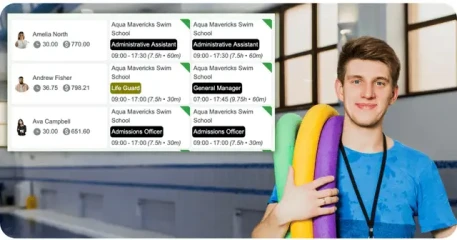In this guide:
- Roster budgeting steps with worked examples.
- AU awards, penalties & Right to Disconnect.
- Copy-ready templates, checklists & tables.
To reduce labour costs without cutting service, forecast demand, set a target labour %, convert it to daily wage caps, and build the roster to those caps. Enforce reality with accurate time and attendance, daily approvals, and award checks before publishing. Use blended rates for weekdays/Sat/Sun/PH, publish rosters predictably with the RosterElf App, align communications with the Right to Disconnect, and integrate to payroll with award-aware payroll exports.

Table of Contents

Key Facts (AU)
- Superannuation Guarantee: 12% from 1 July 2025 — update loaded hourly rates. (ATO: How much super to pay)
- Record-keeping: Keep time & wages records for 7 years. (FWO: Record-keeping)
- Roster changes: Many awards require ~7 days’ notice for changes (check your award).
- Penalty rates: Evenings, weekends, and public holidays (award-specific). (FWO: Penalty rates)
- Right to Disconnect: Applies to small businesses from 26 Aug 2025. (FWO: Right to disconnect)

What Counts as Labour Cost?
Labour cost (AU) = wages and salaries plus on-costs: 12% Super Guarantee (from 1 July 2025), payroll tax, workers’ comp, allowances, leave accruals. Use this loaded figure for budgeting and to set realistic hour caps. (ATO: SG rate)
Two Control Ratios
- Labour Cost % = (Total Labour Cost ÷ Gross Sales) × 100
- SPLH (Sales per Labour Hour) = Sales ÷ Paid Hours
Track Labour % to protect the P&L and SPLH to protect productivity.
Do
- Calculate budgets with loaded rates (base + super + allowances + penalties).
- Review ratios weekly and by day.
Don’t
- Budget with base wage only.
- Wait for payroll to reveal overruns.
Build rosters to a labour budget with live dollars in RosterElf Rostering.

Benchmarks for AU Hospitality
A common starting target for restaurants in Australia is a labour band in the mid-20s to mid-30s of sales. Tune by format (café/QSR/full-service), location, seasonality and penalty exposure. Validate rates using the Fair Work PACT tool and award pay guides.
What Drives Your Target
- Format & service model: Cafés and QSR can run leaner in certain dayparts; full-service venues need more skilled coverage.
- Location & footfall: CBD lunch peaks vs suburban evening peaks change how you staff hours.
- Menu complexity: Prep-heavy menus need earlier coverage; simplify on slower weeks.
- Penalty exposure: Saturdays, Sundays and public holidays can shift your weekly ratio quickly—budget with day-type blended rates.
- Seasonality & events: School holidays, weather and local events reshape demand curves.
Use Blended (Loaded) Rates by Day Type
Maintain separate rates for Weekday / Saturday / Sunday / Public Holiday so your hour caps reflect real costs. Recalculate after 1 July each year and when awards update. Reference: ATO SG (12% from 1 July 2025).
Quick Benchmark Table (Illustrative — replace with your award figures)
| Venue Type | Starting Labour % Target | Planning Cue |
|---|---|---|
| Cafe / QSR | 24–30% | Staff to transaction peaks; feather breaks into soft minutes. |
| Casual Dining | 26–33% | Protect dinner peaks with skill tags; trim shoulder hours. |
| Full-Service | 28–36% | Menu complexity drives prep; consider a tighter close to avoid overtime. |
| Multi-Site Group | Portfolio-weighted | Standardise templates; compare SPLH by daypart across venues. |
Pair Labour % with SPLH
Don’t chase a lower percentage at the expense of service. Track Sales per Labour Hour (SPLH) alongside labour % by daypart; a falling SPLH with a flat labour % is a red flag for over-staffing or misplaced coverage.
Workflow Tip
Build day-type templates inside RosterElf Rostering (Standard / Event / Wet Weather / School Holidays / Public Holiday) and set live roster dollars so managers hit targets before publishing.

Roster Budgeting Framework (How-to)
Labour budget (per day) = Forecast Sales × Target Labour %.
Hour cap = Daily Wage Budget ÷ Blended Loaded Hourly Rate.
1. Forecast Demand
Use bookings, POS transactions, local events and even weather to map peaks and troughs by day and by hour. Save roster templates for Standard, Event Day, Wet Weather, School Holidays, and Public Holidays inside RosterElf Rostering.
2. Set Target Labour % → Convert to Daily Wage Caps
Example: Weekly sales forecast = $40,000. Target labour % = 28%. Weekly wage budget = $11,200. Split into daily caps by expected sales pattern to prevent over-staffing on quieter days.
3. Translate Dollars to Hours with Blended Rates
Maintain loaded rates for Weekday / Saturday / Sunday / Public Holiday. Re-check annually on 1 July when the Super Guarantee changes or when awards update. Confirm rates with PACT and award pay guides.
4. Build the Roster to Budget
View live roster dollars while creating shifts; lock the roster only when the total matches the daily/weekly cap. Use skill tags (barista, FOH lead, grill) so coverage is protected with fewer hours. (Learn more)
5. Publish Predictably
A predictable notice window reduces no-shows and overtime scrambles. Publish via the RosterElf App and coordinate logistics in Employee Team Chat, under a Right-to-Disconnect-aware policy.
6. Enforce Reality
Capture clock-ins/outs, approve exceptions daily, and push approved hours straight to payroll via Payroll Integration.
Quick Recap — 8-Step Loop
- Forecast demand
- Pick target labour %
- Convert to daily wage caps
- Translate to hours (blended rates)
- Build to cap with live roster dollars
- Publish predictably
- Enforce with T&A and compliance checks
- Adjust daily when sales vary
Run a pre-publish compliance check with AI Fair Work Compliance Bot.
Time & Attendance = Real Savings
Time & Attendance discipline narrows the plan-to-pay gap: accurate clock-ins/outs with photo or PIN, break capture, reason codes for early/late/overtime, and same-day approvals stop payroll leakage before it happens.
Why It Matters
- Even small rounding errors add up across dozens of staff and weeks of trading.
- Missed breaks or unapproved overtime expose you to Fair Work record-keeping requirements and backpay risks.
- Clean T&A data provides a 7-year digital audit trail in line with Business.gov.au employee record obligations.
Do
- Approve time exceptions daily, not at payroll run.
- Use reason codes to coach repeat late finishes or missed breaks.
- Integrate approved data into payroll to eliminate re-keying errors.
Don’t
- Rely on paper timesheets — they fail compliance tests.
- Round shifts in 15-minute blocks — minutes matter to labour cost %.
- Ignore breaks — missed break penalties can stack with weekend or late-night penalties.
Tighten control with RosterElf Time & Attendance and push approved hours to payroll automatically via Payroll Integration.
Fair Work & Award Essentials
Modern Awards (e.g., Hospitality MA000009, Restaurant MA000119) define minimum pay, penalty rates, overtime triggers, breaks, and roster change notice. Always check your classification level and confirm pay with Fair Work’s PACT tool.
Penalty Rates
Higher pay applies for evenings, weekends, and public holidays under most awards. See FWO: Penalty rates.
Public Holidays
Check entitlements and substitute days by state/territory. See FWO: Public holidays.
Breaks
Awards set specific meal/rest break rules. Missing a required break can attract extra pay until the break is taken. See FWO: Breaks.
Roster Changes
Most awards require around 7 days’ notice of roster changes (Hospitality Award clause 15.5/15.6; Restaurant Award clause 15.3(d)). See Hospitality Award (MA000009) and Restaurant Award (MA000119).
Missed Meal Break Penalty (HIGA)
If staff don’t get their meal break within the award-prescribed window, additional pay applies until the break is taken. See FWO Library: Missed meal breaks (Hospitality Award).
Check rosters before publishing with the AI Fair Work Compliance Bot to prevent breaches around penalties, breaks, or overtime.
Right to Disconnect, Casuals & Super
Right to Disconnect gives employees the right to refuse unreasonable out-of-hours contact. For small businesses (<15 employees), this applies from 26 August 2025. Publish rosters predictably and define urgent-only contact rules.
Right to Disconnect
The new workplace right means staff can decline calls, texts, or emails outside their working hours if contact is not reasonable. Define “reasonable” in your policy (e.g., emergencies vs. routine updates). See FWO: Right to Disconnect.
Tip: Use Employee Team Chat to keep communications transparent, with notification rules that respect quiet hours.
Casual Employment Changes
From August 2024, the definition of a casual changed, with clearer conversion pathways for regular casuals. Review patterns of work and contracts to ensure they align with reality. Guidance: FWO: Right to Disconnect & Casual Changes.
Superannuation Guarantee
From 1 July 2025, the Superannuation Guarantee (SG) rate is 12%. Update your blended hourly rates and payroll settings to avoid underpayment. See ATO: How much super to pay.
Do
- Define what counts as reasonable contact in your policies.
- Publish rosters earlier through the RosterElf App.
- Review casual patterns to avoid misclassification risks.
- Update payroll for 12% SG from July 2025.
Don’t
- Send routine after-hours messages without policy cover.
- Ignore conversion triggers for regular casuals.
- Budget with pre-July 2025 super rates.
Staffing Smarter (Cross-Training, Leave & Comms)
Smarter staffing balances cost and coverage: cross-train staff, keep leave visible in planning, and set communication norms that respect the Right to Disconnect. This reduces overtime, surprises, and churn.
Cross-Training
Build multi-station capability so one employee can flex across roles — e.g., a barista who can also close, or a FOH lead who can run pass. This lets you cover micro-peaks without calling in extra casuals or pushing into overtime.
Leave Visibility
Approve leave early and keep it visible in your roster builder. Using RosterElf Leave Management prevents surprise gaps, over-staffing, or declined entitlements.
Team Communications
Use Employee Team Chat for scheduling logistics, shift swaps, and open shift alerts. Set clear norms so that after-hours contact is limited to urgent only cases, in line with the Right to Disconnect.
Micro-Case Snapshots
- CBD café: shifted deep-cleaning to Tuesday, cross-trained two baristas for closing duties → overtime down 18% in four weeks.
- Suburban bistro: added a Saturday floater only during top SPLH hours → labour % reduced by 1.9 points with no service dip.
Add skill tags and refresh your templates in RosterElf Rostering (Standard / Event / Wet Weather / PH) to make smarter use of staff.
Worked Examples + Blended Rate Table
Note: Always validate rates and penalties with Fair Work’s PACT and the latest award pay guides.
Example A — Weekly Target & Build (Restaurant, NSW)
- Forecast weekly sales: $40,000
- Target labour %: 28% → Weekly wage budget = $11,200
Daily Split (Match Sales Pattern)
- Mon $4,500 → $1,260
- Tue $5,000 → $1,400
- Wed $5,300 → $1,484
- Thu $6,000 → $1,680
- Fri $7,500 → $2,100
- Sat $8,000 → $2,240
- Sun $3,700 → $1,036
Saturday Hour Cap (Illustrative)
Use a Saturday blended rate (base + 12% super + typical allowances + Saturday penalties). Example: $41.00 → $2,240 ÷ $41.00 ≈ 54.6 hours.
Place Prep / Grill / Pass / Section / Bar / Close packs, then schedule meal breaks within award windows to avoid penalties. See FWO: Breaks and Missed meal breaks (HIGA).
Tip: View live roster dollars and only publish when totals meet the cap in RosterElf Rostering.
Example B — Mid-Week Variance Action (Retail)
It’s 2:00 pm Wednesday; sales track 20% below forecast due to rain.
- Pull one floater hour and bring a break forward into the soft period.
- Convert one close to an early finish (approved in-app).
- Notify via Employee Team Chat and log the reason to improve next week’s forecast.
Example C — Minutes Matter (Compounding Micro-Savings)
30 staff × 15 minutes/week saved = 7.5 hours. At a blended $36/hour, that’s $270/week or $14,000/year — without touching peak coverage. Tighten approvals and break capture in Time & Attendance and export to payroll via Payroll Integration.
Blended Rate Table (Illustrative — Replace with Your Award Numbers)
Recalculate after 1 July each year (SG 12% from 2025) and when awards update. See ATO: Super Guarantee.
| Day Type | Base Pay (ex.) | On-Costs (12% super + allowances) | Expected Penalties | Blended Rate |
|---|---|---|---|---|
| Weekday | $31.00 | $4.50 | $0.00 | $35.50 |
| Saturday | $31.00 | $4.50 | $5.50 | $41.00 |
| Sunday | $31.00 | $4.50 | $10.50 | $46.00 |
| Public Holiday | $31.00 | $4.50 | $26.50 | $62.00 |
Enter these day-type rates into RosterElf Rostering to calculate hour caps automatically and keep daily totals inside budget.
Checklists You Can Copy
Roster Budgeting (AU)
- Sales forecast by day/daypart completed
- Target labour % agreed for the period
- Daily wage caps set per venue/department
- Blended rates updated (Weekday / Sat / Sun / PH; includes 12% SG from 1 July 2025)
- Skills tagged; templates (Standard / Event / Wet Weather / PH) up to date
- Live roster dollars visible while building → RosterElf Rostering
- Predictable publish window; policy aligned to Right to Disconnect
- Breaks scheduled to award windows → FWO: Breaks
- AI Fair Work checks passed pre-publish → Compliance Bot
- Clock rules set; daily approvals in place → Time & Attendance
- Leave visible in planning → Leave Management
- Export mapped/tested → Payroll Integration
Shift-Swap & Communications (Right-to-Disconnect-Aware)
- Same role/skill; equal or lower cost impact
- ≥ 24 hours notice (except emergencies)
- Manager approval; reasons and time logged
- Swaps preserve breaks/minimum engagements/overtime rules
- After-hours contact limited to urgent-only; use Employee Team Chat with clear notification norms
State & Public Holiday Notes
Public holiday calendars differ by state and territory and can affect entitlements, substitute days and penalty exposure. Always validate against the current year’s list and your award: FWO: Public holidays.
How to Plan for Public Holidays
- Create a PH roster template in RosterElf Rostering with shorter trading hours (if applicable), skill coverage for peaks, and PH-specific blended rates.
- Budget with a PH blended rate (base + 12% SG + allowances + PH penalties) so your hour caps reflect real costs.
- Schedule breaks inside award windows to avoid missed-break penalties (these can stack with PH penalties). See FWO: Breaks.
- Publish rosters early and define urgent-only contact rules (Right to Disconnect) for last-minute changes.
Notes by State/Territory (summary)
- NSW / VIC: Additional local observances may apply (e.g., regional show days). Check the state list each year.
- QLD: Some holidays (e.g., Show holidays) vary by locality — confirm dates specific to your LGA.
- WA / SA: Substitute days are common when holidays fall on weekends — validate before rostering.
- TAS: Multiple regional holidays across councils; ensure venue-specific calendars are used.
- ACT / NT: Review local declarations and substitute days; adjust PH templates accordingly.
Add a “Public Holiday” template in RosterElf Rostering so managers don’t rebuild from scratch every time.


